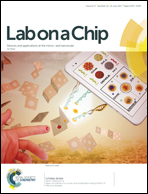Porous PDMS structures for the storage and release of aqueous solutions into fluidic environments†
Abstract
Typical microfluidic systems take advantage of multiple storage reservoirs, pumps and valves for the storage, driving and release of buffers and other reagents. However, the fabrication, integration, and operation of such components can be difficult. In particular, the reliance of such components on external off-chip equipment limits their utility for creating self-sufficient, stand-alone microfluidic systems. Here, we demonstrate a porous sponge made of polydimethylsiloxane (PDMS), which is fabricated by templating microscale water droplets using a T-junction microfluidic structure. High-resolution microscopy reveals that this sponge contains a network of pores, interconnected by small holes. This unique structure enables the sponge to passively release stored solutions very slowly. Proof-of-concept experiments demonstrate that the sponge can be used for the passive release of stored solutions into narrow channels and circular well plates, with the latter used for inducing intracellular calcium signalling of immobilised endothelial cells. The release rate of stored solutions can be controlled by varying the size of interconnecting holes, which can be easily achieved by changing the flow rate of the water injected into the T-junction. We also demonstrate the active release of stored liquids into a fluidic channel upon the manual compression of the sponge. The developed PDMS sponge can be easily integrated into complex micro/macro fluidic systems and prepared with a wide array of reagents, representing a new building block for self-sufficient microfluidic systems.



 Please wait while we load your content...
Please wait while we load your content...